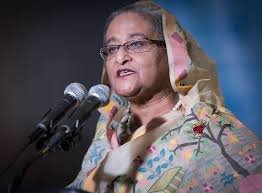Sheikh Hasina, the daughter of Bangladesh’s founding father Sheikh Mujibur Rahman, has been a central figure in the country’s political landscape for decades. As the current Prime Minister, she has led Bangladesh through significant economic and social transformations. However, her journey has been anything but smooth, marked by periods of political turmoil, exile, and personal tragedy.
Early Life and Political Involvement
Born on September 28, 1947, Sheikh Hasina was deeply influenced by her father’s vision for Bangladesh. After the independence of Bangladesh in 1971, Sheikh Mujibur Rahman became the country’s first Prime Minister, setting the stage for Hasina’s future in politics. Her involvement in politics became more pronounced after the tragic assassination of her father and most of her family members in 1975.

The Tragedy of 1975
On August 15, 1975, Sheikh Mujibur Rahman, along with most of his family members, was brutally murdered in a military coup. Sheikh Hasina and her sister, Sheikh Rehana, survived as they were in West Germany at the time. The assassination marked a dark chapter in Bangladesh’s history and left Sheikh Hasina and her sister as the sole survivors of the Mujib family.

Exile in India
Following the assassination, Sheikh Hasina was forced into exile, and she spent the next six years in India. During this period, she faced immense personal grief but also began to solidify her political resolve. While in exile, she maintained contact with supporters in Bangladesh and began organizing the Awami League, the political party founded by her father. Her time in India was crucial in shaping her future political strategies and in building alliances that would later support her return to Bangladesh.
Return to Bangladesh and Political Ascendancy
In 1981, Sheikh Hasina returned to Bangladesh and took over the leadership of the Awami League. Her return marked the beginning of her relentless struggle to restore democracy in a country that had been under military rule since her father’s assassination. Over the years, Sheikh Hasina led numerous movements against military dictatorships and fought for the restoration of civilian rule.

Challenges and Leadership
Sheikh Hasina’s political career has been marked by significant challenges, including attempts on her life, imprisonment, and political opposition. Despite these hurdles, she has remained a resilient leader, determined to fulfill her father’s vision for Bangladesh. Under her leadership, Bangladesh has seen substantial economic growth, improvements in infrastructure, and progress in social sectors such as education and healthcare.
Legacy and Current Role
Today, Sheikh Hasina stands as one of the longest-serving Prime Ministers in the world, having served multiple terms since 1996. Her leadership has been pivotal in transforming Bangladesh into one of the fastest-growing economies in the world. However, her tenure has not been without controversy, with critics pointing to issues of human rights and democratic backsliding.

Conclusion
Sheikh Hasina’s journey from exile to leadership is a testament to her resilience and dedication to her country. Despite facing immense personal and political challenges, she has remained a steadfast leader, guiding Bangladesh through periods of turmoil and growth. Her legacy is one of perseverance, shaped by the tragedies of her past and her unwavering commitment to her father’s dream of a prosperous and independent Bangladesh.
No Responses